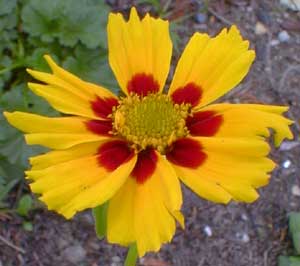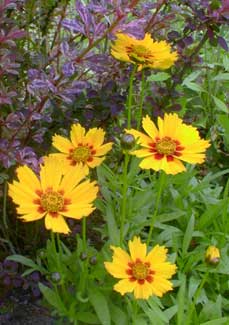
'Sonnenkind' aka 'Baby Sun'
Lanceleaf Coreopsis or Tickseed
"See how the flowers, as at parade,
Under their colours stand display'd."
-Andrew Marvell
(1621‚1678)
(1621‚1678)
'Baby Sun' is a cultivar of Coreopsis lancelolata (which in the nursery trade is treated as synonymous with C. grandiflora), a native wildflower of the southeastern United States. The name 'Baby Sun' is meant to describe this floriferous perennial's daisy-bloom, in flower by June & most numerous July & August. It has bright golden petals radiating from an orange-gold eye ringed in maroon flecks.
It is sufficiently drought-hardy to put in a low-maintenance full-sun garden, though at the height of a droughty summer it should have some water gotten to it.
 Mature clumps average a foot & a half tall & wide, being fairly compact & a bit shorter than the species, hence not as prone to "lodging" or tippiness as are two to three foot tall varieties. If grown in humusy or too often damp soil, lodging is inevitable, but grown in a poor dryish soil, it ought to remain upright without staking. Older clumps may eventually become prone to lodging, which is an indicator the clump needs to be dug up, divided, & replanted.
Mature clumps average a foot & a half tall & wide, being fairly compact & a bit shorter than the species, hence not as prone to "lodging" or tippiness as are two to three foot tall varieties. If grown in humusy or too often damp soil, lodging is inevitable, but grown in a poor dryish soil, it ought to remain upright without staking. Older clumps may eventually become prone to lodging, which is an indicator the clump needs to be dug up, divided, & replanted.On Puget Sound & along the coast, full sun is really best, but inland or in the south, it can do quite well in a bit of shade, if not too much. It is almost always disease-free except for a problem of crown-rot if planted in soil that drains poorly or which stays too wet in the winter.
If a young start is not noticeably larger its second year, this means it is staying too wet during the winter, keeping it from the stoliniferous spread expected of a successful clump. This also means it will probably slowly die out of the garden if it is not possible to shelter it from persistent heavy rainfall in autumn & winter, or provide it with a more swiftly draining soil. In conditions they like, the clump will swiftly broaden, & may need division as often as every other year.
New basal leaves emerge in autumn & linger as evergreen or semi-evergreen through the winter. In very exposed harsh areas, the basal leaves may die to the ground after all, but will return happily in early spring.
Though it neither likes nor needs much fertilizing, toward the end of winter a very light feeding of a mild slow-release fertilizer doesn't hurt. Or fertilizing can be restricted to a thin, protective winter mulching of fully composted manure.
Deadheading of spent summer flowers is recommended, as this will induce rebloom for early autumn. If the last flowers are left to go to seed, these will be the small black fruits that lend the genus the common name "Tickseed," & even the genus name alludes to this resemblance to a bug.